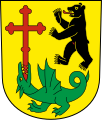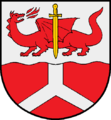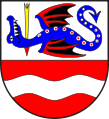Lindworm

Lindwurm ( Old High German lint "snake") is the name of a snake - or dragon-like mythical creature .
etymology
The word has been attested since the 9th century. It comes from the Old High German and Middle High German lintwurm . In Old Norse there is the noun linnormr , which is a tautological combination to clarify two nouns with the same meaning. Old High German lint and Old Norse linnr or linni mean "snake". The old high German adjective lindi with the meaning "soft, yielding" is related to it. The Old High German worm as well as the Old Norse ormr also mean "snake" or denote any creeping creature.
mythology
The Lindwurm is usually two-legged, but four or more legs are also possible. It resembles a dragon and is sometimes referred to as a subspecies, has no or only short wings and is mentioned above all in ancient Germanic sagas . A lindworm usually has a long tail and short legs, and is sometimes described as man-eating. The "dragon" Fafnir in the song of the Nibelungs is a dragon.
The Lindwurm is the landmark of the Austrian city of Klagenfurt am Wörthersee and the Slovenian capital Ljubljana (Laibach). In places that have Limb or Lind in their names, a dragon saga is often passed down, for example in Limburg an der Lahn .
Heraldry
The Lindwurm is a heraldic animal and thus a mean figure . In essence crest ( Heraldry ) of the dragon is displayed in different ways: as described above or as a crowned footless. He is less often shown with a rooster head, which can lead to confusion with basilisks .
The dominant coloring ( tinging ) is black, that of the dragon is green, this is often mentioned fire-breathing, which is less common in the dragon. Confusion with the heraldic dragon cannot be ruled out. In the representation in the coat of arms , the coat of arms bearer should be limited to a mythical creature , a snake with the hind legs of a lion .
To identify it as a lindworm, a linden tree or, in relation to the lindworm of the Roland song , a sword is often assigned as an attribute.
- Coats of arms of places
Bad Goisern on Lake Hallstatt , Austria
Bandenitz , Mecklenburg-Western Pomerania
Bayerbach , Bavaria
Beatenberg , Switzerland
Bobzin , Mecklenburg-Western Pomerania
Elpersdorf near Windsbach , Bavaria
Ennetmoos , Switzerland
Gossau SG , Switzerland
Hainstadt , Baden-Wuerttemberg
Hattingen , North Rhine-Westphalia
Hohenwart , Bavaria
Jevenstedt , Schleswig-Holstein
Office of Jevenstedt , Schleswig-Holstein
Klagenfurt am Wörthersee , Austria
Liezen , Austria
Ljubljana , Slovenia
Marktbreit , Bavaria
Murnau am Staffelsee , Bavaria
Orneta (German Wormditt), Poland
Rheden , Lower Saxony
Schwarzenberg , Saxony
Stjørdal , Norway
Surava , Switzerland
Trutnov , Czech Republic
Wachtberg , North Rhine-Westphalia
Wurmannsquick , Lower Bavaria
Wurmlingen near Rottenburg, Baden-Wuerttemberg
Wurmlingen near Tuttlingen, Baden-Württemberg
See also
- Lambton Lindworm (Northern English folk tale)
- Tatzelwurm (mythical animal)
- List of mythical creatures
literature
- Harald Gebhardt, Mario Ludwig : Of dragons, yetis and vampires. On the trail of mythical animals. BLV, Munich 2005, ISBN 3-405-16679-9 .
- Dictionary entry: Lindwurm. In: Brothers Grimm : German dictionary . Volume 12. Leipzig 1854–1961, column 1038/1039 (on woerterbuchnetz.de).
Web links
- Alfred von Reumont: Siegfried's fight with the lindworm (1837). In: Deutschland-im-Mittelalter.de. Steffen Schnieders, private website, 2007–2014.
- Word entry: Lindwurm. In: Digital dictionary of the German language .
Individual evidence
- ↑ Wolfgang Pfeifer u. a .: Etymological dictionary of German. 8th edition. DTV, Munich 2005, ISBN 3-423-32511-9 , p. 803 (first edition: 1989).
- ↑ Dictionary entry: Lindwurm. In: Brothers Grimm : German dictionary . Volume 12. Leipzig 1854–1961, column 1038 (on woerterbuchnetz.de); Quote: "LINDWURM, m. Dragon. ahd. lintwurm, linduurm, linuurum jaculus Graff 1, 1044, mhd. lintwurm; a tautological composition in which the simple lint snake, which was already very rare in the ahd. , is explained by worm in the same meaning. "
- ^ Friedrich Kluge , edited by Elmar Seebold : Etymological Dictionary of the German Language . 24th, revised and expanded edition. de Gruyter, Berlin / New York 2001, ISBN 978-3-11-017473-1 , p. 577.
- ↑ Dictionary entry: worm. In: Brothers Grimm : German dictionary . Volume 30. Leipzig 1854–1961, column 2226–2259, here column 2226 (on woerterbuchnetz.de); Quote: “WURM, m., N., Creeping; snake, dragon; worm (vermis), made, caterpillar; beetle, insect. "





























